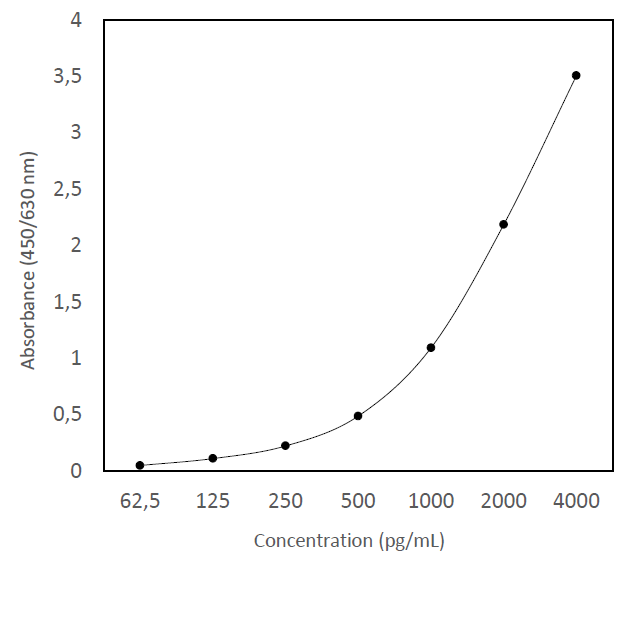
Description
Enzyme immunoassay for the quantitative determination of Osteopontin (OPN) in human serum or plasma samples. Quality controls are included with the kit. Developed and manufactured in Europe by PromedeusLab.
Summary
Osteopontin (OPN), a secreted multifunctional phosphoprotein, is a member of the small integrin-binding ligand N-linked glycoprotein (SIBLING) family of cell matrix proteins and participates in many biological activities. OPN has been demonstrated to be closely related to the occurrence and development of many bone-related diseases, such as osteoporosis, rheumatoid arthritis, and osteosarcoma (1). Besides that, it functions as a proinflammatory cytokine and promotes cell-mediated immune responses, and also has protective functions such as biomineralization and wound healing, and is also a strong predictor of adverse outcomes in patients with CVDs. Thus, OPN is not only a risk factor but also a potential therapeutic target for CVDs (2).
Other Names
Bone sialoprotein 1, Nephropontin, Secreted phosphoprotein 1 (SPP-1), Urinary stone protein, Uropontin, SPP1, BNSP, UniProtKB# P10451.
Principle of Method
The microtiter plate is coated with the antibody specifically binding the Osteopontin. The human serum or plasma is incubated in the plate with the capture antibody.
The specimen is washed out and the specifically bound protein is incubated with biotin-labelled detection antibody. Following another washing step, Streptavidin-HRP conjugate is added into the well. Unbound reagent is then washed out. Horseradish peroxidase (HRP) bound in the complex reacts with the chromogenic substrate (TMB) creating the blue colour. The reaction is stopped by addition of STOP solution (H2SO4).
The absorbance values are measured at 450 nm (optionally 450/630 nm) and are proportional to the concentration of Osteopontin in the specimen. The concentration of Osteopontin in unknown samples is determined from the calibration curve which is created by plotting the absorbance values against the standard concentration values.
Sample Types
Serum, Plasma
Typical Standard Curve
Assay Range: 0.156 pg/mL - 10 pg/mL

Sensitivity
The limit of detection, defined as a concentration of human Osteopontin giving absorbance higher than absorbance of blank + 3 standard deviations, is better than 1.56 pg/mL of sample.
Precision
Intra-Assay
| Test sample | Mean (ng/mL) | SD | CV |
| 1 |
8.8 |
0.4 |
4.3% |
| 2 |
54.4 |
2.1 |
3.9% |
Inter-Assay (Run-to-Run)
| Test sample | Mean (ng/mL) | SD | CV |
| 1 |
7.8 |
0.2 |
2.8% |
| 2 |
52.3 |
2.1 |
3.9% |
Accuracy
Dilution Linearity:
| Test sample | Dilution |
Measured Concentration (ng/mL) |
Expected Concentration (ng/mL) |
Yield |
| 1 |
54.4 |
- | - | |
| 1 | 2x | 28.4 |
27.2 |
104% |
| 1 | 4x | 15.0 |
13.6 |
111% |
| 1 | 8x | 7.8 |
6.8 |
115% |
| 2 |
39.8 |
- |
- | |
| 2 | 2x | 19.8 |
19.9 |
99% |
| 2 | 4x | 10.1 |
9.9 |
101% |
| 2 | 8x | 4.7 |
5.0 |
95% |
Spiking Recovery:
| Test sample | Spike (ng/mL) |
Measured Concentration (ng/mL) |
Expected Concentration (ng/mL) |
Yield |
| 1 |
- | 8.8 |
- | - |
| 1 | 25.0 |
28.2 |
33.8 |
83% |
| 1 | 6.3 |
13.4 |
15.0 |
89% |
| 1 | 3.1 |
10.7 |
11.9 |
90% |
Storage
The kit must be stored at 2–8 °C. The opened components can be stored for one week at 2–8 °C.
Usage
This assay is for in vitro research use only and is not for use in diagnostic procedures.
Resources
Summary References
- Si J, Wang C, Zhang D, Wang B, Zhou Y. Osteopontin in Bone Metabolism and Bone Diseases. Med Sci Monit. 2020 Jan 30;26:e919159. doi: 10.12659/MSM.919159. PMID: 31996665; PMCID: PMC7003659.
- Shirakawa K, Sano M. Osteopontin in Cardiovascular Diseases. Biomolecules. 2021 Jul 16;11(7):1047. doi: 10.3390/biom11071047. PMID: 34356671; PMCID: PMC8301767.
Ilex Life Sciences LLC is an authorized distributor of PromedeusLab.
